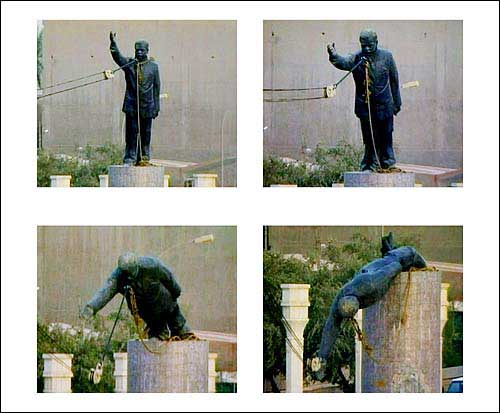Baghdad falls
Celebrations break out as regime ends
Baghdad, Iraq ? They used shoes and slippers, sledgehammers, cardboard boxes, sticks and garbage. Joyous Baghdad residents pelted just about anything they could find Wednesday at the toppled statue of Saddam Hussein — the most potent symbol of the Iraqi leader’s stunningly swift demise.
“Now my son can have a chance in life,” said Bushra Abed, pointing to her 2-year-old son, Ibrahim, as they watched the statue come down in central Baghdad with the help of U.S. Marines — images that were broadcast throughout the Arab world and beyond.
Hours later, in the darkened streets in northern Baghdad early today, U.S. Marines engaged in a fierce fire fight, using heavy machine guns. An undetermined Iraqi force used rocket-propelled grenades, hitting some American vehicles. There was no immediate word on casualties from the three-hour fight near a presidential palace.
On Wednesday, there were signs of mixed emotion toward U.S. forces. Marines briefly covered Saddam’s face with an American flag, and were greeted with silence. They quickly replaced it with the Iraqi flag, to cheers from the crowd.
There was also scattered sniper fire directed at the U.S. troops, and fighting broke out in some parts of the city. In one neighborhood, hundreds of Iraqis who’d been cheering American troops came under heavy automatic weapons fire at sunset, apparently from Iraqi fighters. At least six people were killed in a car riddled by bullets.
But mostly, it was a day for celebrating — when fear of the regime began to melt, and hope surged across the Iraqi capital.
Watching U.S. troops move through the city in armored convoys, people flooded the streets to cheer. Women lifted their babies for the soldiers to kiss. Young men shouted in English, “Bush No. 1, Bush No. 1.”
“I’m 49, but I never lived a single day. Only now will I start living,” Yussuf Abed Kazim, a mosque preacher, said as he whacked tile and concrete off the pedestal of the toppled statue.

A smiling Iraqi boy flashes V-for-victory signs as he walks with U.S. Marines in the Iraqi capital of Baghdad. Jubilant crowds swarmed into Baghdad's streets Wednesday, dancing, looting and defacing images of Saddam Hussein as U.S. commanders declared that his regime's rule over the capital had ended.
Many in the crowd beat their chests and chanted, “There is a burning in our chests,” a Shiite Muslim slogan. Celebrations were particularly strong in Baghdad’s Shiite neighborhoods, like Saddam City in the northeast. In one area, hundreds of jubilant Shiites shouted, “There is no God but Allah!” waving palm fronds and prayer stones.
But the enduring symbol of the day was surely the toppling of the towering Saddam statue, a gesture that recalled the frenzied euphoria that swept Eastern Europe and the Soviet Union more than a decade ago. Then, it was a statue of Lenin that came tumbling down.
Saddam’s statue in al-Firdos (Paradise) Square was in the same Soviet style, depicting the Iraqi president standing tall in a civilian suit, right arm raised in a wave to his people. It was one of his most popular poses; tens of thousands of his images can be found in this nation of some 26 million people.
This one stood in the middle of a large roundabout ringed with columns in front of the blue-domed Shahid, or Ramadan 14th, Mosque. The tops of the columns are engraved with Saddam’s initials.
It began in the afternoon, when the crowd tried to knock the metal statue off its pedestal by chipping away at the base with sledgehammers. That didn’t work. Then they tried a rope around the neck. Still no success.
Finally the Marines stepped in, with a winch on a tank recovery vehicle. The first pull brought the statue onto its stomach, dangling off its 25-foot-high pedestal as the crowd pelted it with garbage.

A 40-foot statue of Iraqi President Saddam Hussein is toppled by U.S. troops in al-Firdos (Paradise) Square in Baghdad, Iraq. The fall of the statue Wednesday has come to be a symbol of the U.S. capture of the capital city.
Another tug, and it broke in half, leaving only the twisted metal of the feet with two rusted pipes sticking out.
With the 40-foot bronze statue now flat on the ground, men surged forward and climbed on top of it, dancing on the chest and face before beating it with sledgehammers. “Hit the eye, hit the eye,” one of them cried.
Iraqis and U.S. Marines hugged, high-fived or shook hands. Some of the Marines held their rifles aloft in a victorious pose. Women ululated and men cheered. Groups of men offered prayers of thanks.
Others dragged the torn-off head through the streets, while children rode it and beat it with shoes and slippers — a grave insult in the Arab world.
“I don’t like to see a foreign army in Iraq,” said Abed, the mother who watched the statue come down. “But all those who tried to get rid of him were killed. We have no choice, we lived in so much fear,” she said.








